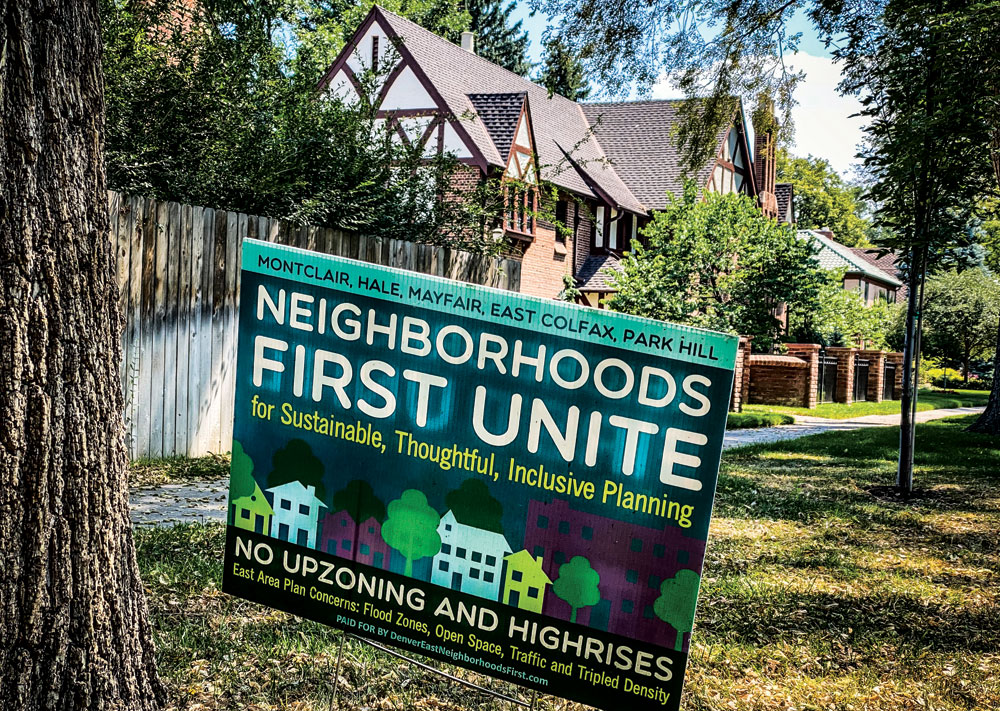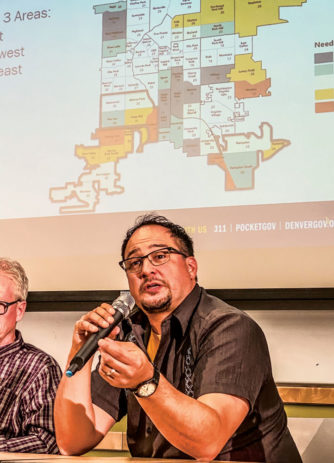![]()

Two former City Councilmen share their thoughts on long-term impacts of the pandemic, particularly on economic development and housing. Proposed zoning changes for group housing and allowing accessory dwelling units (ADUs) in single-family zoning have raised concerns among some homeowners, as evidenced by this yard sign.
![]() While a recent Wall Street Journal (WSJ) article suggests that other cities may look to Denver for insights on how to recover from the pandemic, former City Councilman Albus Brooks says he and others on the City of Denver’s new Long-Term Recovery Committee (LTRC) are also looking at other urban areas to understand best practices as the City moves forward. Though he agrees with the WSJ that “Denver is well-positioned to come out of Covid-19 the fastest because of our economic prowess,” as a longtime advocate for equity, he hopes pandemic recovery fundamentally shifts our urban landscape to promote economic parity as well. “We’re trying to make sure that the most impacted and vulnerable communities receive resources and receive our attention, and make sure that they come out and grow with the community along with everyone else.”
While a recent Wall Street Journal (WSJ) article suggests that other cities may look to Denver for insights on how to recover from the pandemic, former City Councilman Albus Brooks says he and others on the City of Denver’s new Long-Term Recovery Committee (LTRC) are also looking at other urban areas to understand best practices as the City moves forward. Though he agrees with the WSJ that “Denver is well-positioned to come out of Covid-19 the fastest because of our economic prowess,” as a longtime advocate for equity, he hopes pandemic recovery fundamentally shifts our urban landscape to promote economic parity as well. “We’re trying to make sure that the most impacted and vulnerable communities receive resources and receive our attention, and make sure that they come out and grow with the community along with everyone else.”

Former City Councilman Albus Brooks joins marchers in the MLK Marade. Front Porch file photo
For Brooks, the work of the LTRC goes well beyond repairing the economic damage wrought by the pandemic. “Covid is an opportunity for us to rebuild as a city and rebuild with an equitable lens. We see equity…not just as a noun but as an action word.” He recalls the push back he would receive as a Councilman seeking to promote women- and minority-owned businesses: ‘“Why are we investing in those businesses? They need to work hard just like everybody else,’ were some of the comments that we received. I think now people are understanding that we live in a divided America.” To that end, the LTRC will promote recovery in a way “that everyone recovers and makes sure that those who are behind get a jump start ahead.” In concrete terms, this may include technical support, small business loans and grants, reduced red tape and reduced fees to promote small businesses.
Though Denver is already working towards more walkable and bike-friendly neighborhoods, Brooks hopes pandemic recovery will heighten that momentum to include better home-work balance and a more sustainable urban landscape after residents saw the less congested streets, clearer skies and shorter drive times. In the beginning of the pandemic, bikes shops “say they tripled their business during these three months. I personally probably rode 500-600 miles.” Brooks, who served on Denver City Council from 2011-19, now works in the private sector as Vice President of Business Development and Strategy for Milender White Construction Company.

Former City Councilman Rafael Espinoza speaks about zoning at a community meeting. Front Porch file photo
Another former City Councilman, Rafael Espinoza (not affiliated with the LTRC), speaks as an architect and a resident in a growing neighborhood about his personal ideas for how the City can address its need for more housing—with or without a pandemic. “Planning and building affordable housing in a growing city is difficult in good times. The loss of revenue to the City caused by the pandemic will make the future housing needs in Denver even more acute and difficult to address,” says Espinoza.
Underutilized industrial areas in Denver with old warehouses and big parking lots next to RTD rail lines generate little revenue for the City, says Espinoza. If those areas were redeveloped with multi-story housing units and ground floor retail adjacent to stops, the value of the property would increase, bringing in more property taxes. But more importantly, the development would be filled with Denver residents paying sales and use taxes, which bring in more than five times as much revenue to the City as property tax. The City then would have revenue to build amenities (like rec centers and libraries) for the newly developed areas—and that would also serve surrounding neighborhoods.
The most cost-effective construction for such developments, says Espinoza, would be by private developers. The City should set zoning requirements and offer incentives (more size, height and number of units; both reduced and deferred fees; expedited permitting; and partial property tax rebates) and developers would figure out the most cost-effective way to build what the city needs and wants. The City could, for example, designate a number of affordable bedrooms required for permitting and allow developers to reach that number by including some unique floor plans or more basic units.
As part of a broader approach to more housing, Espinoza believes accessory dwelling units (ADUs) should be allowed everywhere in the city provided the footprint of the house remains unchanged—but says agreement by adjoining property owners needs to be required if the house is being expanded to add an ADU.
Additionally, says Espinoza, when an area is identified for transit oriented development or mapped for growth, it should be high density —the City should make it unattractive to build three-story townhomes in areas zoned for 12-story buildings adjacent to publicly-funded transit infrastructure.




0 Comments